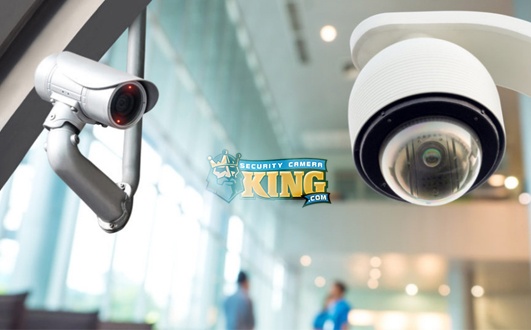An IP network security camera can provide security and peace of mind for businesses and homes. Crime is always a reality in the world we live in. Safety and security are important responsibilities for businesses and homeowners.
Although there are many different security cameras that can continuously monitor a property, none provide the flexibility that IP network security cameras do. The following article will detail what consumers need to know about IP network security cameras including how they work and what to consider.
If you would like to browse a wide selection of security cameras for sale, including IP network security cameras, be sure to browse our online security camera store. For sales assistance, contact Security Camera King directly.
What Are IP Security Cameras?
In the simplest terms, a network security camera, sometimes referred to as IP cameras, works a lot like traditional security cameras. The major difference lies in how they send and receive data. IP cameras are similar to the webcams used in computers in that the internet is used to send and store recorded images.
Network security cameras can be divided into two categories: centralized and decentralized. Below, we will examine these two camera setups.
Centralized IP Camera Systems
In a centralized network camera, a central Network Video Recorder (NVR) is required in order to manage incoming recordings, video storage, and alarm soundings if the camera is connected to an alarm system.
An NVR is commonly mistaken with a DVR or Digital Video Recorder. An NVR is a software program designed to store and record video from a network security camera in a digital format.
The digital videos can be saved to a digital mass storage device, like an SD memory card. The software of the NVR is stored in a dedicated device that can connect to the various IP cameras in the property.
When comparing NVRs with DVRs, the main difference is that an NVR receives video data from an internet network while a DVR receives it directly from the camera. How video is processed and encoded is another major difference.
NVRs process and encode video signals before being sent to the recording device. By contrast, a DVR processes and encodes video after they are streamed to the unit.
Decentralized IP Camera Systems
In a decentralized network security camera system, the NVR is not used. Instead, these security cameras are designed with built-in video storage capabilities including flash drives and hard disk drives.
Although this method of storage is streamlined, there are a number of limitations, including not being able to store large amounts of data.
Choosing Between Centralized and Decentralized
Choosing between decentralized and centralized network security camera systems will depend largely on the needs of the property. Both systems have their advantages.
In addition to choosing between centralized and decentralized network cameras, the type of security IP cameras that are needed must be considered.
Network Security Camera Types
A network security camera is available to consumers in a variety of designs and formats. This opens up a number of possibilities for consumers to monitor and secure their home, business, or commercial property.
Within camera types, manufacturers may alter with certain features. For the most part, however, every network security camera is based on the following types highlighted below.
Outdoor IP Security Cameras
As the name suggests, outdoor network security cameras are designed to be used outdoors. These network security cameras are designed with weatherproof casings, large temperature operation range, night and day recording, and anti-tamper features.
Most properties will use outdoor IP cameras to monitor open campuses, parking lots, streets, and any setting that requires monitoring in all weather conditions twenty-four hours.
Thermal Surveillance Cameras
There are a number of situations in which an area will be covered in complete darkness. Thermal IP cameras are used in these settings to capture images using the heat radiating from objects. All objects, especially organisms, emit some kind of heat. A thermal IP camera uses this heat to capture important details.
The major advantage of thermal security cameras is that they can monitor a property that is completely shrouded in darkness. Individuals in this setting will be unaware that they are being monitored. The only disadvantage of this design is that there is a lack of major details. Figures can be easily seen but smaller details are lost in the process.
Megapixel IP Security Cameras
A megapixel IP security camera is designed to capture extremely detailed images. These cameras are designed using cutting edge high-resolution surveillance technology.
Sometimes, these cameras are referred to as UHDTV cameras. They are typically used when a high level of detail is required. For example, megapixel network cameras can clearly capture facial features from long distances.
Covert Security Cameras
In some instances, it will be necessary to monitor an area covertly. As their name suggests, covert security cameras are designed to remain hidden and blend into the environment.
Individuals are unaware that these cameras are recording and can capture details including their actions. Businesses will sometimes implement covert network cameras to monitor areas of a business that are difficult to monitor.
PTZ Dome Cameras
When a property needs to discreetly monitor a wide-angle area, PTZ security cameras are considered the best type to accomplish this. PTZ dome cameras are housed in a dome casing that leaves individuals unaware of where the camera is pointing.
What makes this camera type special is its ability to be manually tilted, zoomed, and pan while capturing high-resolution images. Some features typically found in PTZ dome network cameras include electronic image stabilization, auto-tracking, and auto camera flip.
Fixed IP Cameras
This is the most common network security camera design. It is visible to onlookers and the lens cannot be moved. Instead, the field of view is static.
Many fixed network cameras allow users to change their lenses. This can change the available field of view of the camera.













